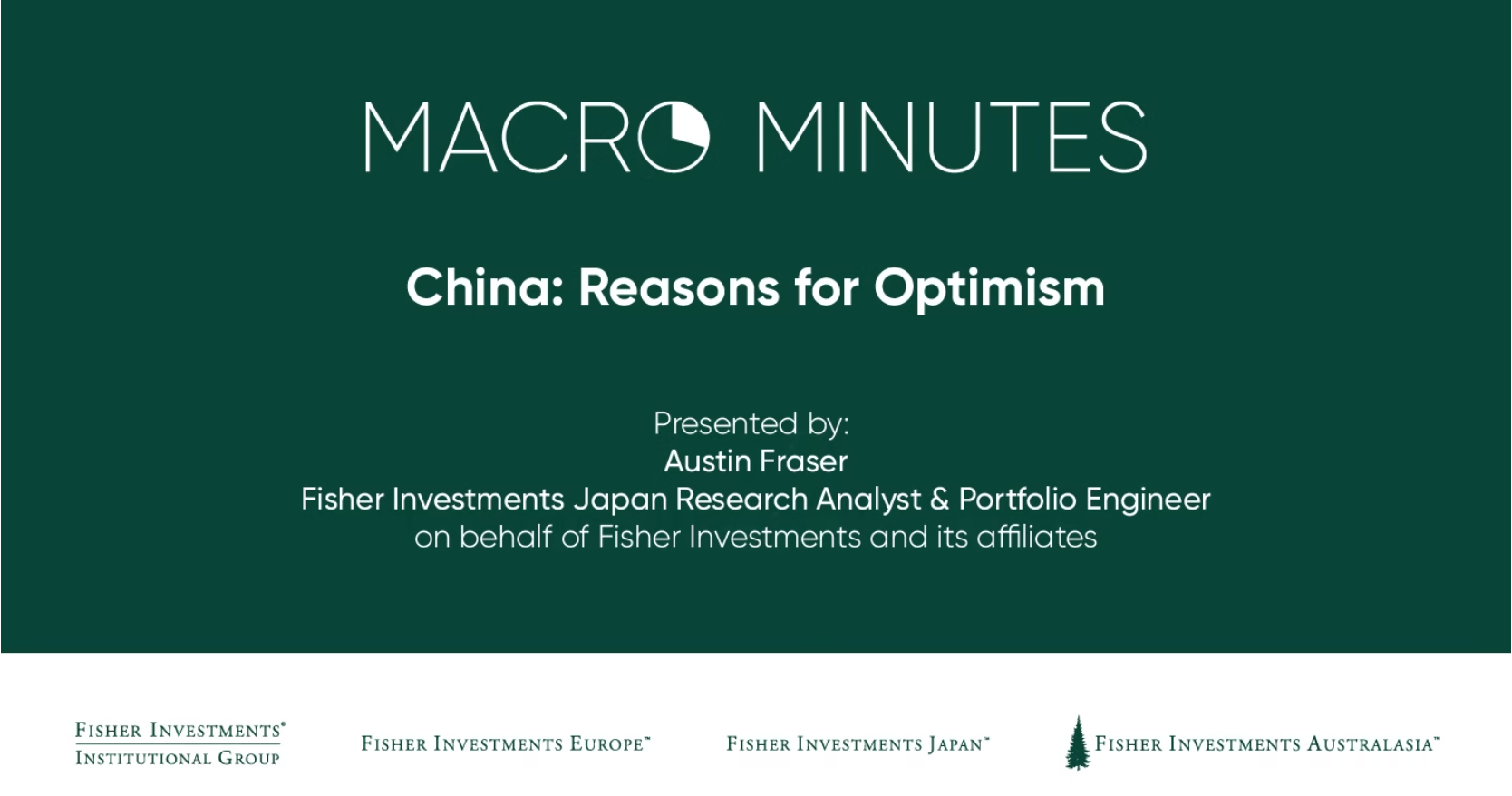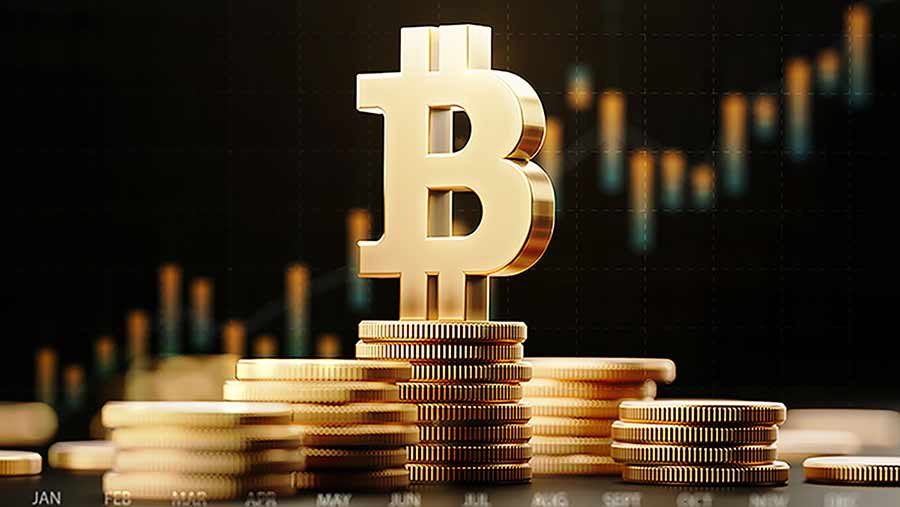Institutional Investing / Macro Minutes
Macro Minutes: China: Reasons for Optimism

In our latest Macro Minutes video, Portfolio Engineer Austin Fraser discusses Fisher Investments’ optimistic views of China’s equity markets and examines the catalysts behind China’s positive performance, despite global, developed, and emerging equity markets’ negative performance.
Key Points
- The Chinese government has backed off its regulatory push that weighed heavily on sentiment since last year, removing a major headwind for equities moving forward.
- The Chinese government is actively stimulating and supporting the economy ahead of the National Party Congress this fall.
- History suggests a relatively quick economic recovery following the lifting of COVID-restrictions, and China’s June economic activity provided early signs of a rebound.
Transcript
Video title screen appears, "China: Reasons for Optimism"
Austin Fraser appears on the screen wearing a black suit with a blue tie
Austin Fraser: Hi, my name is Austin Fraser and I'm a research analyst and portfolio engineer here at Fisher Investments. And today we're going to be talking about a reasons to be optimistic for Chinese equities.
Screen shows a line chart for "Easing Chinese Regulations".
Escalating Chinese regulations spooked and contributed to a Chinese and Emerging markets bear market in 2021. However, Chinese regulators have changed their tone recently. Below are some examples of easing regulation.
Austin Fraser: So beginning in July of 2021, the Chinese government instituted a very strong regulatory push that weighed heavily on the sentiment for Chinese equities and was a big reason in our view, why you saw a bear market in Emerging Markets as well as Chinese equities. But recently, there's been some positive developments in Chinese shares a rallied fairly considerably. They're the best performing market since mid-March and you've seen things like the first batch of video game approvals in April and first time in nearly a year.
Austin Fraser: And again, we saw more video game approvals coming in July. Other things like the cybersecurity probe ending for DD global.com allowing it to accept new users for the first time at some time as well as bigger macro things like compromises from the Chinese government with the US government related to the Holding Foreign Companies Accountable Act that threatens to delist Chinese shares. All of this in our view has removed a major headwind to equities and you can see on the chart here the Chinese equities have rallied fairly considerably this in our view is like to continue.
Screen shows a bar chart for "Economic growth typically accelerates in party congress years".
The average Relative GDP Growth from CAGR is under -0.6% 2 years prior to the year of congress, and a little over -0.6% 1 year prior to the year of congress. On the year of congress, it jumps to more than 1.0%, and 1 year after it is in between 0.4% and 0.6%, and 2 years after it goes down in between 0.0% and – 0.2%.
Austin Fraser: The government's highest priority right now is economic stability and some of us to do with the lockdowns that you've seen over the past several months. But another reason is very much political in nature. Every five years. China has its largest political event the Party Congress and that'll happen later this year. And you can see by this chart here that economic growth tends to accelerate going into those Party Congress years and that makes some logical sense given that the government wants to promote stability and good order before it goes into this major political event, and part of the way that they do that is through stimulus.
Screen shows two line charts for "Credit growth typically accelerates into party congress".
Credit growth often accelerates ahead of China’s Party Congress – next scheduled for October 2022 – Which could support China’s economy this year.
Austin Fraser: This year has seen significant stimulus so far in part because of the lockdowns, but there's also a political element to it in our view, because credit growth actually bottomed back in October of last year as you can see that the top chart here in this slide. We expect this trend to continue in credit growth to accelerate in the second half of this year. You can see on the bottom chart the credit impulse which is really the second derivative of credit growth this turn from deeply negative to positive.
Austin Fraser: Moreover, The government has talked about bringing for Local Government Bond issuance for the first time from next year. It's also not just credit that's been a part of the stimulus measures the government has introduced a significant supply-side tax cuts from about three percent of GDP. You take all this stimulus together and it's one reason we believe the economy should stabilize in the second half of this year and most likely be better than expected.
Screen shows 2 charts for "Signs of economic activity rebounding post-lockdowns" and the charts display’s China’s lockdowns negatively impacted economic growth, but history suggests the effect will be temporary.
Austin Fraser: As I mentioned lockdowns have clearly had a negative impact on economic growth, but history tells us that the effect is most likely to be temporary and we can look at examples in the developed world as well as China in 2020. You see the chart here on the left in this slide which plots GDP from the pre-pandemic level essentially measuring how quickly does economic activity recover following the restrictions put in place and you can see the develop markets which we're looking at US, UK, Europe and Japan then on average they recovered fairly quickly from those restrictions in 2020. China also did, as well in 2020.
Austin Fraser: But of course, the most recent Omicron outbreak has led to further decline in economic activity. We'd expect that to rebound very meaningfully here over the course of a few months and we've gotten some initial encouraging signs within the June data. Table here on the right in this slide shows you some of the major economic indicators for China and how they came in much better than consensus in June as well as accelerated from May. Now China is unlikely to lift its zero Covid policy in our view, at least not any time soon, but officials have built significant infrastructure following the most recent lockdowns, including things like mass testing that should allow for a much more targeted and localized approach to managing Covid outbreaks.
Austin Fraser: This means in our view that the ultimate economic impact of future restrictions are going to be significantly less because you're unlikely to see the large widespread lockdowns like you saw in Shanghai and Beijing.
Austin Fraser appears on the screen wearing a black suit with a blue tie
Austin Fraser: And thank you very much for watching today. If you have any more questions about our views, please reach out to your relationship manager.
A message appears on the screen: “Thank for watching! If you would like to learn about our views, please reach out to your relationship manager or email FisherInstitutional@fi.com”
“Background music”
A series of disclosures appear on the screen:” Investing in financial markets involves the risk of loss and there is no guarantee that all or capital invested will be repaid. Past performance neither guarantees nor reliably indicates future performance. The value of investments and the income from them will fluctuate with world financial markets and international currency exchange rates”
“Background music”
See Our Institutional Insights
Stay on top of the latest investment trends and developments with our views and research.







